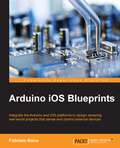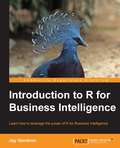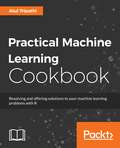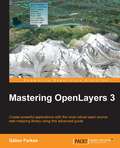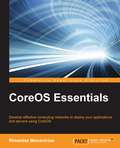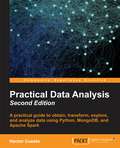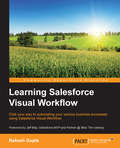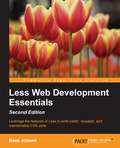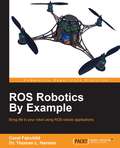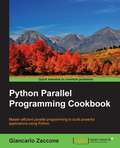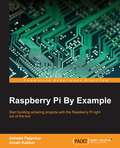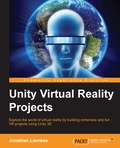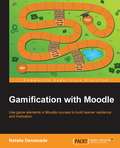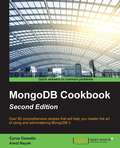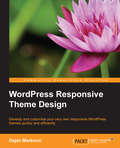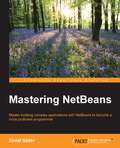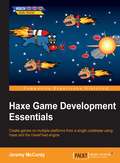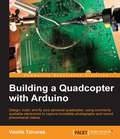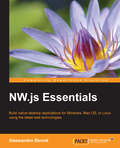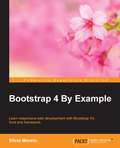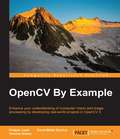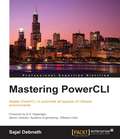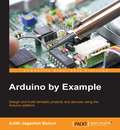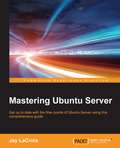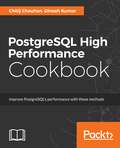- Table View
- List View
Arduino iOS Blueprints
by Fabrizio BocoIntegrate the Arduino and iOS platforms to design amazing real-world projects to sense and control external devices About This Book * Cover the most widely used methods in the Internet of Things using Arduino and iOS integration through Wi-Fi Shield and the BLE Breakout board * Design five real-world projects including of electronics, Arduino code, and an iOS application that seamlessly work together * A detailed guide that covers various sensors and actuators through which Arduino interacts with the world including a light sensor, hall effect sensor, accelerometer, servo motor, DC motor, and TRIAC for power line loads Who This Book Is For This book is a technical guide for Arduino and iOS developers who have a basic knowledge of the two platforms but want to learn how to integrate them. The book includes a lot of external references to additional documentation and learning materials, so even if you are less experienced, you can improve your knowledge on the subjects covered. What You Will Learn * Design circuits with Arduino using sensors and actuators * Write code to handle analog and digital sensors with the most used protocols including OneWire, I2C, and SPI) * Store data on SD Card and in EEPROM * Build iOS applications using the MCV pattern and the UIKit components * Allow your applications to control Arduino and its hooked-up devices * Manage TCP/IP, UDP, and Bluetooth BLE communication between Arduino and iOS devices * Make your iOS application take advantage of the sensors available in the iOS devices including accelerometer, gyroscope, and compass * Develop iOS applications that use iBeacons In Detail Arduino and iOS devices have reached wide popularity due to their simple way of use and flexibility. Hence, their integration opens up new opportunities, allowing everyone to build devices that are extremely useful in everyday life. You will first learn how to control Arduino from an iPhone or iPad by writing the Arduino sketch, the iOS application, and integrating everything together via Wi-Fi or Bluetooth BLE. You will then learn about various components that interact with the Arduino such as digital and analog I/O, Wi-Fi shield, Bluetooth BLE, SD card, OneWire, I2C, and so on. You will also learn about iOS, which includes the development of an application from scratch, GUI design and MVC, UIKit, iOS sensors, TCP and Bluetooth BLE communication, and more. All the projects are described in detail, providing you with a learning tool, not just some sketches or some iOS code to copy. Style and approach This is a project-based book with a step-by-step guide that covers everything that you need to build an Arduino-iOS project, right from defining the basic requirements to the coding and testing the entire project. Each chapter ends with ideas on how to improve the project and to constantly learn the topics covered.
Introduction to R for Business Intelligence
by Jay GendronLearn how to leverage the power of R for Business Intelligence About This Book * Use this easy-to-follow guide to leverage the power of R analytics and make your business data more insightful. * This highly practical guide teaches you how to develop dashboards that help you make informed decisions using R. * Learn the A to Z of working with data for Business Intelligence with the help of this comprehensive guide. Who This Book Is For This book is for data analysts, business analysts, data science professionals or anyone who wants to learn analytic approaches to business problems. Basic familiarity with R is expected. What You Will Learn * Extract, clean, and transform data * Validate the quality of the data and variables in datasets * Learn exploratory data analysis * Build regression models * Implement popular data-mining algorithms * Visualize results using popular graphs * Publish the results as a dashboard through Interactive Web Application frameworks In Detail Explore the world of Business Intelligence through the eyes of an analyst working in a successful and growing company. Learn R through use cases supporting different functions within that company. This book provides data-driven and analytically focused approaches to help you answer questions in operations, marketing, and finance. In Part 1, you will learn about extracting data from different sources, cleaning that data, and exploring its structure. In Part 2, you will explore predictive models and cluster analysis for Business Intelligence and analyze financial times series. Finally, in Part 3, you will learn to communicate results with sharp visualizations and interactive, web-based dashboards. After completing the use cases, you will be able to work with business data in the R programming environment and realize how data science helps make informed decisions and develops business strategy. Along the way, you will find helpful tips about R and Business Intelligence. Style and approach This book will take a step-by-step approach and instruct you in how you can achieve Business Intelligence from scratch using R. We will start with extracting data and then move towards exploring, analyzing, and visualizing it. Eventually, you will learn how to create insightful dashboards that help you make informed decisions--and all of this with the help of real-life examples.
Practical Machine Learning Cookbook
by Atul TripathiResolving and offering solutions to your machine learning problems with R About This Book • Implement a wide range of algorithms and techniques for tackling complex data • Improve predictions and recommendations to have better levels of accuracy • Optimize performance of your machine-learning systems Who This Book Is For This book is for analysts, statisticians, and data scientists with knowledge of fundamentals of machine learning and statistics, who need help in dealing with challenging scenarios faced every day of working in the field of machine learning and improving system performance and accuracy. It is assumed that as a reader you have a good understanding of mathematics. Working knowledge of R is expected. What You Will Learn • Get equipped with a deeper understanding of how to apply machine-learning techniques • Implement each of the advanced machine-learning techniques • Solve real-life problems that are encountered in order to make your applications produce improved results • Gain hands-on experience in problem solving for your machine-learning systems • Understand the methods of collecting data, preparing data for usage, training the model, evaluating the model's performance, and improving the model's performance In Detail Machine learning has become the new black. The challenge in today's world is the explosion of data from existing legacy data and incoming new structured and unstructured data. The complexity of discovering, understanding, performing analysis, and predicting outcomes on the data using machine learning algorithms is a challenge. This cookbook will help solve everyday challenges you face as a data scientist. The application of various data science techniques and on multiple data sets based on real-world challenges you face will help you appreciate a variety of techniques used in various situations. The first half of the book provides recipes on fairly complex machine-learning systems, where you'll learn to explore new areas of applications of machine learning and improve its efficiency. That includes recipes on classifications, neural networks, unsupervised and supervised learning, deep learning, reinforcement learning, and more. The second half of the book focuses on three different machine learning case studies, all based on real-world data, and offers solutions and solves specific machine-learning issues in each one. Style and approach Following a cookbook approach, we'll teach you how to solve everyday difficulties and struggles you encounter.
Mastering OpenLayers 3
by Gabor FarkasCreate powerful applications with the most robust open source web mapping library using this advanced guide About This Book * Develop responsive and platform-independent web mapping applications with OpenLayers 3 * Learn the key points of creating great applications with native JavaScript through the step-by-step examples * Master the use of the library, from compiling custom builds to developing a complete WebGIS application Who This Book Is For This book is intended for front-end developers with basic understanding of JavaScript and GIS concepts, and preferably for those who are familiar with the fundamentals of OpenLayers 3. You might have never used OpenLayers 3 as a seasoned JavaScript developer. If this is the case and you are eager to learn web mapping, this book will definitely set you on the right track. What You Will Learn * Use the advanced functionality of the OpenLayers 3 library effectively * Implement the library in your application, shaping it to your needs * Manage layers and the layer stack dynamically * Create not only stunning but also accurate thematic maps * Extend OpenLayers 3 with your own custom classes * Develop mobile-friendly web mapping applications * Make stunning effects with canvas manipulation, or visualize point clouds with WebGL * Integrate third-party applications, and create custom builds that completely satisfy your needs In Detail OpenLayers 3 allows you to create stunning web mapping and WebGIS applications. It uses modern, cutting edge browser technologies. It is written with Closure Library, enabling you to build browser-independent applications without painful debugging ceremonies, which even have some limited fallback options for older browsers. With this guide, you will be introduced to the world of advanced web mapping and WebGIS. First, you will be introduced to the advanced features and functionalities available in OpenLayers 3. Next, you will be taken through the key points of creating custom applications with OpenLayers 3. You will then learn how to create the web mapping application of yours (or your company's) dream with this open source, expense-free, yet very powerful library. We'll also show you how to make amazing looking thematic maps and create great effects with canvas manipulation. By the end of this book, you will have a strong command of web mapping and will be well on your way to creating amazing applications using OpenLayers 3. Style and approach This is an advanced guide packed with comprehensive examples, and it concentrates on the advanced parts of OpenLayers 3 and JavaScript. It intentionally skips the basic and well-known methodologies, but discusses the hard-to-understand ones in great detail.
CoreOS Essentials
by Rimantas MoceviciusIf you are a system administrator with experience in network virtualization and want to develop computing networks for deploying applications and servers, then this is the book for you. Knowledge of Linux operating systems and Docker is expected.
Practical Data Analysis - Second Edition
by Hector Cuesta Dr Sampath KumarA practical guide to obtaining, transforming, exploring, and analyzing data using Python, MongoDB, and Apache Spark About This Book * Learn to use various data analysis tools and algorithms to classify, cluster, visualize, simulate, and forecast your data * Apply Machine Learning algorithms to different kinds of data such as social networks, time series, and images * A hands-on guide to understanding the nature of data and how to turn it into insight Who This Book Is For This book is for developers who want to implement data analysis and data-driven algorithms in a practical way. It is also suitable for those without a background in data analysis or data processing. Basic knowledge of Python programming, statistics, and linear algebra is assumed. What You Will Learn * Acquire, format, and visualize your data * Build an image-similarity search engine * Generate meaningful visualizations anyone can understand * Get started with analyzing social network graphs * Find out how to implement sentiment text analysis * Install data analysis tools such as Pandas, MongoDB, and Apache Spark * Get to grips with Apache Spark * Implement machine learning algorithms such as classification or forecasting In Detail Beyond buzzwords like Big Data or Data Science, there are a great opportunities to innovate in many businesses using data analysis to get data-driven products. Data analysis involves asking many questions about data in order to discover insights and generate value for a product or a service. This book explains the basic data algorithms without the theoretical jargon, and you'll get hands-on turning data into insights using machine learning techniques. We will perform data-driven innovation processing for several types of data such as text, Images, social network graphs, documents, and time series, showing you how to implement large data processing with MongoDB and Apache Spark. Style and approach This is a hands-on guide to data analysis and data processing. The concrete examples are explained with simple code and accessible data.
Learning Salesforce Visual Workflow
by Rakesh GuptaLearning Salesforce Visual Workflow is intended for those who want to use Flows to automate their business requirements by click not code. Salesforce maintains an incredibly user-friendly interface; no previous experience in computer coding or programming is required.
Less Web Development Essentials - Second Edition
by Bass JobsenIf you use CSS for web development tasks and want to learn how to create maintainable and reusable code, this is the book for you. Basic knowledge of web development would be helpful.
ROS Robotics By Example
by Dr Thomas Harman Carol FairchildBring life to your robot using ROS robotic applications About This Book * This book will help you boost your knowledge of ROS and give you advanced practical experience you can apply to your ROS robot platforms * This is the only book that offers you step-by-step instructions to solidify your ROS understanding and gain experience using ROS tools * From eminent authors, this book offers you a plethora of fun-filled examples to make your own quadcopter, turtlebot, and two-armed robots Who This Book Is For If you are a robotics developer, whether a hobbyist, researchers or professional, and are interested in learning about ROS through a hands-on approach, then this book is for you. You are encouraged to have a working knowledge of GNU/Linux systems and Python. What You Will Learn * Get to know the fundamentals of ROS and apply its concepts to real robot examples * Control a mobile robot to navigate autonomously in an environment * Model your robot designs using URDF and Xacro, and operate them in a ROS Gazebo simulation * Control a 7 degree-of-freedom robot arm for visual servoing * Fly a quadcopter to autonomous waypoints * Gain working knowledge of ROS tools such as Gazebo, rviz, rqt, and Move-It * Control robots with mobile devices and controller boards In Detail The visionaries who created ROS developed a framework for robotics centered on the commonality of robotic systems and exploited this commonality in ROS to expedite the development of future robotic systems. From the fundamental concepts to advanced practical experience, this book will provide you with an incremental knowledge of the ROS framework, the backbone of the robotics evolution. ROS standardizes many layers of robotics functionality from low-level device drivers to process control to message passing to software package management. This book provides step-by-step examples of mobile, armed, and flying robots, describing the ROS implementation as the basic model for other robots of these types. By controlling these robots, whether in simulation or in reality, you will use ROS to drive, move, and fly robots using ROS control. Style and approach This is an easy-to-follow guide with hands-on examples of ROS robots, both real and in simulation.
Python Parallel Programming Cookbook
by Giancarlo ZacconeMaster efficient parallel programming to build powerful applications using Python About This Book * Design and implement efficient parallel software * Master new programming techniques to address and solve complex programming problems * Explore the world of parallel programming with this book, which is a go-to resource for different kinds of parallel computing tasks in Python, using examples and topics covered in great depth Who This Book Is For Python Parallel Programming Cookbook is intended for software developers who are well versed with Python and want to use parallel programming techniques to write powerful and efficient code. This book will help you master the basics and the advanced of parallel computing. What You Will Learn * Synchronize multiple threads and processes to manage parallel tasks * Implement message passing communication between processes to build parallel applications * Program your own GPU cards to address complex problems * Manage computing entities to execute distributed computational tasks * Write efficient programs by adopting the event-driven programming model * Explore the cloud technology with DJango and Google App Engine * Apply parallel programming techniques that can lead to performance improvements In Detail Parallel programming techniques are required for a developer to get the best use of all the computational resources available today and to build efficient software systems. From multi-core to GPU systems up to the distributed architectures, the high computation of programs throughout requires the use of programming tools and software libraries. Because of this, it is becoming increasingly important to know what the parallel programming techniques are. Python is commonly used as even non-experts can easily deal with its concepts. This book will teach you parallel programming techniques using examples in Python and will help you explore the many ways in which you can write code that allows more than one process to happen at once. Starting with introducing you to the world of parallel computing, it moves on to cover the fundamentals in Python. This is followed by exploring the thread-based parallelism model using the Python threading module by synchronizing threads and using locks, mutex, semaphores queues, GIL, and the thread pool. Next you will be taught about process-based parallelism where you will synchronize processes using message passing along with learning about the performance of MPI Python Modules. You will then go on to learn the asynchronous parallel programming model using the Python asyncio module along with handling exceptions. Moving on, you will discover distributed computing with Python, and learn how to install a broker, use Celery Python Module, and create a worker. You will also understand the StarCluster framework, Pycsp, Scoop, and Disco modules in Python. Further on, you will learn GPU programming with Python using the PyCUDA module along with evaluating performance limitations. Next you will get acquainted with the cloud computing concepts in Python, using Google App Engine (GAE), and building your first application with GAE. Lastly, you will learn about grid computing concepts in Python and using PyGlobus toolkit, GFTP and GASS COPY to transfer files, and service monitoring in PyGlobus. Style and approach A step-by-step guide to parallel programming using Python, with recipes accompanied by one or more programming examples. It is a practically oriented book and has all the necessary underlying parallel computing concepts.
Raspberry Pi By Example
by Ashwin Pajankar Arush KakkarStart building amazing projects with the Raspberry Pi right out of the box About This Book * Explore the vast range of opportunities provided by Raspberry Pi and other hardware components such as a webcam, the Pi camera, and sensors * Get hands-on experience with coding, networking, and hardware with the Raspberry Pi platform * Learn through ample screenshots that offer a play-by-play account of how to implement Raspberry-Pi-based real-life projects Who This Book Is For What's the best way to learn how to use your Raspberry Pi? By example! If you want something exciting to do whilst getting to grips with what your Pi can offer, this is the book for you. With both simple and complex projects, you'll create a wide variety of cool toys and functions with your Raspberry Pi - all with minimal coding experience necessary. What You Will Learn * Set up your Raspberry Pi and get it ready for some interesting real-life projects * Work with images, videos, webcams, and the Pi camera and create amazing time-lapse videos * Explore the amazing world of Minecraft Pi * Get to know how to use PiGlow for GPIO programming * Interface your Pi with Grove Sensors and implement IoT applications * Build your own cluster with Raspberry Pi * Understand the networking and network programming fundamentals In Detail Want to put your Raspberry Pi through its paces right out of the box? This tutorial guide is designed to get you learning all the tricks of the Raspberry Pi through building complete, hands-on hardware projects. Speed through the basics and then dive right in to development! Discover that you can do almost anything with your Raspberry Pi with a taste of almost everything. Get started with Pi Gaming as you learn how to set up Minecraft, and then program your own game with the help of Pygame. Turn the Pi into your own home security system with complete guidance on setting up a webcam spy camera and OpenCV computer vision for image recognition capabilities. Get to grips with GPIO programming to make a Pi-based glowing LED system, build a complete functioning motion tracker, and more. Finally, get ready to tackle projects that push your Pi to its limits. Construct a complete Internet of Things home automation system with the Raspberry Pi to control your house via Twitter; turn your Pi into a super-computer through linking multiple boards into a cluster and then add in advanced network capabilities for super speedy processing! Style and approach This step-by-step guide to building Raspberry-Pi-based projects is explained in a conversational and easy-to-follow style. Each topic is explained sequentially in the process of creating real-life projects, and detailed explanations of the basic and advanced features of various Python libraries are also included.
Unity Virtual Reality Projects
by Jonathan LinowesExplore the world of Virtual Reality by building immersive and fun VR projects using Unity 3D About This Book * Learn the basic principles of virtual reality applications and get to know how they differ from games and desktop apps * Build various types of VR experiences, including diorama, first-person characters, riding on rails, 360 degree projections, and social VR * A project-based guide that teaches you to use Unity to develop VR applications, which can be experienced with devices such as the Oculus Rift or Google Cardboard Who This Book Is For If you're a non-programmer unfamiliar with 3D computer graphics, or experienced in both but new to virtual reality, and are interested in building your own VR games or applications then this book is for you. Any experience in Unity is an advantage. What You Will Learn * Create 3D scenes with Unity and Blender while learning about world space and scale * Build and run VR applications for consumer headsets including Oculus Rift and Google Cardboard * Build interactive environments with physics, gravity, animations, and lighting using the Unity engine * Experiment with various user interface (UI) techniques that you can use in your VR applications * Implement the first-person and third-person experiences that use only head motion gestures for input * Create animated walkthroughs, use 360-degree media, and build multi-user social VR experiences * Learn about the technology and psychology of VR including rendering, performance and VR motion sickness * Gain introductory and advanced experience in Unity programming with the C# language In Detail What is consumer "virtual reality"? Wearing a head-mounted display you view stereoscopic 3D scenes. You can look around by moving your head, and walk around using hand controls or motion sensors. You are engaged in a fully immersive experience. On the other hand, Unity is a powerful game development engine that provides a rich set of features such as visual lighting, materials, physics, audio, special effects, and animation for creating 2D and 3D games. Unity 5 has become the leading platform for building virtual reality games, applications and experiences for this new generation of consumer VR devices. Using a practical and project-based approach, this book will educate you about the specifics of virtual reality development in Unity. You will learn how to use Unity to develop VR applications which can be experienced with devices such as the Oculus Rift or Google Cardboard. We will then learn how to engage with virtual worlds from a third person and first person character point of view. Furthermore, you will explore the technical considerations especially important and possibly unique to VR. The projects in the book will demonstrate how to build a variety of VR experiences. You will be diving into the Unity 3D game engine via the interactive Unity Editor as well as C-Sharp programming. By the end of the book, you will be equipped to develop rich, interactive virtual reality experiences using Unity. So, let's get to it! Style and approach This book takes a practical, project-based approach to teach specifics of virtual reality development in Unity. Using a reader-friendly approach, this book will not only provide detailed step-by-step instructions but also discuss the broader context and applications covered within.
Gamification with Moodle
by Natalie DenmeadeUse game elements in Moodle courses to build learner resilience and motivationAbout This BookFormulate a Moodle course that acts as a flexible framework ready for your own contentKeep learners engrossed and create opportunities for motivation through the concepts of status, access, and powerA resourceful guide to innovative learning using automatic reports, assessments, and conditional release of activitiesWho This Book Is ForThis book has been designed for teachers who to use technology to create more engaging learning experiences for both online learning and in face-to-face sessions. This book will especially appeal to people who are interested in the underlying mechanics of play and games and want to know more about applying these concepts in an educational context. It is assumed that you are a teacher and expert in your field, have basic computer skills, and have access to the Internet.What You Will LearnSet up a scoring system using Moodle GradebookEnable communication and collaboration in your class as a Learning Community using forumsAssess your learners' abilities by setting up challenges and questsConfigure gateways to check and ensure progress before new content or activities are releasedCreate Moodle assignments to provide effective feedback through a comment bank and custom scaleIssue Open Badges to recognize achievements and set up an online backpack to share digital badgesReduce anxiety for learners by using the game-like concept of "Levelling Up"In DetailThis book describes how teachers can use Gamification design within the Moodle Learning Management System. Game elements can be included in course design by using, badges, rubrics, custom grading scales, forums, and conditional activities. Moodle courses do not have to be solo-learning experiences that replicate Distance Education models.The Gamification design process starts by profiling players and creating levels of achievement towards meeting learning outcomes. Each task is defined, valued, and sequenced. Motivation loops are devised to keep the momentum going. In a gaming studio, this approach would require a team of specialists with a large budget and time frames. Preparing for a class rarely has these optimal conditions. The approach used in this book is to introduce game elements into the course design gradually. First, apply gamification to just one lesson and then build up to gamifying a series of lessons over a term. Each example will indicate the difficulty level and time investment. Try it out to see what is most effective with your learners and choose wisely in your use of technology.By the end of the book, you will be able to create gripping Moodle courses for effective and efficient learning.Style and approachAn easy-to-follow guide full of screenshots and step-by-step instructions with estimated time frames required to accomplish numerous tasks. Tips are offered for new Moodlers and plugin extensions are suggested for advanced Moodlers. The focus of the book is on why you would want to use each activity rather than detailed technical descriptions.
MongoDB Cookbook - Second Edition
by Amol Nayak Cyrus DasadiaHarness the latest features of MongoDB 3 with this collection of 80 recipes - from managing cloud platforms to app development, this book is a vital resourceAbout This BookGet to grips with the latest features of MongoDB 3Interact with the MongoDB server and perform a wide range of query operations from the shellFrom administration to automation, this cookbook keeps you up to date with the world's leading NoSQL databaseWho This Book Is ForThis book is engineered for anyone who is interested in managing data in an easy and efficient way using MongoDB. You do not need any prior knowledge of MongoDB, but it would be helpful if you have some programming experience in either Java or Python.What You Will LearnInstall, configure, and administer MongoDB sharded clusters and replica setsBegin writing applications using MongoDB in Java and Python languagesInitialize the server in three different modes with various configurationsPerform cloud deployment and introduce PaaS for MongoDiscover frameworks and products built to improve developer productivity using MongoTake an in-depth look at the Mongo programming driver APIs in Java and PythonSet up enterprise class monitoring and backups of MongoDBIn DetailMongoDB is a high-performance and feature-rich NoSQL database that forms the backbone of the systems that power many different organizations - it's easy to see why it's the most popular NoSQL database on the market. Packed with many features that have become essential for many different types of software professionals and incredibly easy to use, this cookbook contains many solutions to the everyday challenges of MongoDB, as well as guidance on effective techniques to extend your skills and capabilities.This book starts with how to initialize the server in three different modes with various configurations. You will then be introduced to programming language drivers in both Java and Python. A new feature in MongoDB 3 is that you can connect to a single node using Python, set to make MongoDB even more popular with anyone working with Python. You will then learn a range of further topics including advanced query operations, monitoring and backup using MMS, as well as some very useful administration recipes including SCRAM-SHA-1 Authentication. Beyond that, you will also find recipes on cloud deployment, including guidance on how to work with Docker containers alongside MongoDB, integrating the database with Hadoop, and tips for improving developer productivity.Created as both an accessible tutorial and an easy to use resource, on hand whenever you need to solve a problem, MongoDB Cookbook will help you handle everything from administration to automation with MongoDB more effectively than ever before.Style and approachEvery recipe is explained in a very simple set-by-step manner yet is extremely comprehensive.
WordPress Responsive Theme Design
by Dejan MarkovicIf you are a WordPress enthusiast who wants to develop and customize your own responsive WordPress theme, this book is for you. Some experience with WordPress, HTML, PHP, and CSS is expected and highly recommended.
Mastering NetBeans
by David SalterIf you are a competent developer who wants to fast-track your application development with NetBeans IDE, then this book is for you. Reasonable knowledge and an understanding of Java programming and NetBeans IDE is assumed.
Haxe Game Development Essentials
by Jeremy MccurdyCreate games on multiple platforms from a single codebase using Haxe and the HaxeFlixel engine About This Book * Learn the modern, cross-platform language Haxe to build games without any trouble * Create engaging 2D games that are compatible with desktop, web, and mobile platforms * Learn how to speed up your workflow with OpenFL and HaxeFlixel using this useful and compact guide Who This Book Is For This book is for game developers with some experience programming games on one or more platforms already. If you want to leverage your game development experience on one platform to develop for multiple platforms and to get up and running quickly, this book is for you. Having prior experience with a language similar to Haxe, such as ActionScript or JavaScript will help, but isn't required. What You Will Learn * Understand the fundamentals of the Haxe programming language * Set up a development environment that will work on Windows, Mac, and Linux * Create fun 2D games using OpenFL and HaxeFlixel * Understand how to implement a user interface * Enhance the gameplay experience with cool animations * Improve immersion by adding sound * Make your game modular and easily expandable using configuration files * Compile games that will work on desktop, web, and mobile platforms In Detail Haxe is a powerful and high-level multi-platform language that's incredibly easy to learn. Used by thousands of developers and many high-profile companies, Haxe is quickly emerging as a forerunner in the area of cross-platform programming. OpenFL builds on top of Haxe to make developing for multiple platforms quick and painless. HaxeFlixel provides you with the tools you need to build amazing 2D games easier than ever before. Cross-platform development has been supercharged using the Haxe programming language, making it increasingly easy and hassle-free to develop multi-platform games. If you've programmed games before and want to learn out how to deliver games across multiple platforms, or develop games faster, then Haxe Game Development Essentials is the book for you. It starts by showing you how to set up your development environment, then running you through some Haxe language fundamentals, and finally taking you through the process of programming a game from start to finish. You will learn how to create a side scrolling shooter game using HaxeFlixel. Next you will learn to enhance the game with new gameplay features, user interfaces, animations, sound, and configuration files to make your game expandable. Once your game is built and ready, you will learn how to deploy it to web, Android, iOS, and desktop systems. By the end of this book, you will be confident about creating multi-platform games using Haxe, OpenFL, and HaxeFlixel in a faster and easier way. Style and approach Since this book is aimed at people who have worked on games before, this book is written in a way that will get you quickly up to speed with a new set of tools, but will still be accessible for less experienced developers. Each chapter covers an essential milestone in building a game from start to finish. The chapters move in a logical fashion, starting with the basics of Haxe development and ending with preparing a game for deployment.
Building a Quadcopter with Arduino
by Vasilis TzivarasDesign, build, and fly your personal quadcopter using market electronics to capture incredible photographs and record phenomenal videosAbout This BookGrasp the knowledge required to assemble your drone with light and cost effective materialsEnlighten your understanding about the flight by performing step-by-step pre-flight adjustments and acquiring the instructions for a safe flightGet the best tips to deal with performance issues related to your quadcopterWho This Book Is ForThis book is intended for hobbyists who are looking forward to fulfill their dream of flying a quadcopter clearly made by them. Some basic experience in electronic circuits and aerial vehicles will make it easier for you, however it isn't mandatory.What You Will LearnReview and choose the most suitable material for the buildSet up and calibrate all of your electronic partsControl and fly your quadcopter taking into account the weather conditionsMaintain your vehicle as much as possible and repair it whenever requiredEngineer the structure of your vehicleDevelop a flight controller with its basic principlesEliminate possible malfunctions in the futureRepair your drone if it crashes or faces any damageIn DetailQuadcopters, also known as quadrotors, are gaining more and more popularity in today's world. With the help of these devices, anyone can have an "eye in the sky" and can monitor any place at any time. You can capture photographs and once a while and perform automated tasks. In this book, you will be informed about all the basic modules and electronics needed to fly a simple quadcopter. You'll delve deep to create a fully-functional quadcopter quickly with the help of Arduino boards. Through this book, you'll develop the skills needed to build a DIY drone that can capture pictures and record videos.Style and approachThis is an easy-to-follow guide with pictorial depictions and technical descriptions to assemble your vehicle.
NW.js Essentials
by Alessandro BenoitIf you are an experienced Node.js developer who wants to create amazing desktop applications using NW.js, this is the book for you. Prior knowledge of HTML5, jQuery, and CSS is assumed.
Bootstrap By Example
by Silvio MoretoMaster Bootstrap 4's frontend framework and build your websites faster than ever before About This Book * Become an expert in Bootstrap framework, and speed up front-end development and prototyping through real-life examples * An applied guide exploring two web applications such as Twitter and Dashboard from scratch * Hands on the Bootstrap version 4 even before the official release Who This Book Is For If you are a frontend developer with no knowledge of Bootstrap, then this book is for you. Basic knowledge of HTML, CSS, and JavaScript is expected, as well as a reasonable understanding of web frameworks, such as jQuery. What You Will Learn * Discover how to use Bootstrap's components and elements, and to customize them for your own projects * Understand the framework's usage in the best way with the recommended development patterns * Create web pages for any kind of device like tablet, mobile, computer, etc. * Construct a Twitter app by exploring the advanced bootstrap components like Breadcrumbs, Pagination, Media objects, and so on * Combine the power of JavaScript with your Bootstrap app for more functionality * Create a Dashboard web app using Bootstrap's JavaScript plugins * Learn the difference between Bootstrap's version 3 and 4 of the framework * Extend your knowledge on Bootstrap's external plugins, their incorporation and usage In Detail Bootstrap is a free, open source collection of tools that helps developers create websites or web applications. It provides a faster, easier, and less repetitive solution to designing and building applications. Before Bootstrap's release, it was necessary to import a variety of libraries into your project that offered different components and features for web interface development. Plus with the increased popularity of smartphones there were lack of libraries that could handle the responsiveness of a web page. Bootstrap's existence let it quickly become famous as a front-end framework that offered a wide set of tools from page grid up to components that render a web page in the best possible way for any device. This book will be a tutorial covering various examples as well as step-by-step methodology to create interesting web applications using Bootstrap and to understand the front-end framework to its core. We begin with an introduction to the Bootstrap framework and setting up an environment to build a simple web page. We then cover the grid system, basic Bootstrap components, HTML elements, and customization components for responsive and mobile first development. This is presented by creating a beautiful Landing page sample. You will also learn how to create a web application like Twitter by using the full set of components offered in the framework. Finally, you will learn to create a dashboard web app, using Bootstrap to its finest potential including component customizations, event handling, and external library integration. All these examples are explained step-by-step and in depth, while covering the versions 3 and the most recent version 4 of Bootstrap. So, you will be in the state of the art for front-end development. By the end of this book, you will be familiar with the development of a plugin for the framework and Bootstrap's world which is popular for fast paced front-end web development, used in countless projects all over the world, and now yours. Style and approach This is a step-by-step guide that closely focuses on developing web applications in most objective way solving real-life problems with Bootstrap. It covers two sample web applications, which are explained in detail.
OpenCV By Example
by Prateek Joshi David Millan Escriva Vinicius GodoyEnhance your understanding of Computer Vision and image processing by developing real-world projects in OpenCV 3 About This Book * Get to grips with the basics of Computer Vision and image processing * This is a step-by-step guide to developing several real-world Computer Vision projects using OpenCV 3 * This book takes a special focus on working with Tesseract OCR, a free, open-source library to recognize text in images Who This Book Is For If you are a software developer with a basic understanding of Computer Vision and image processing and want to develop interesting Computer Vision applications with Open CV, this is the book for you. Knowledge of C++ is required. What You Will Learn * Install OpenCV 3 on your operating system * Create the required CMake scripts to compile the C++ application and manage its dependencies * Get to grips with the Computer Vision workflows and understand the basic image matrix format and filters * Understand the segmentation and feature extraction techniques * Remove backgrounds from a static scene to identify moving objects for video surveillance * Track different objects in a live video using various techniques * Use the new OpenCV functions for text detection and recognition with Tesseract In Detail Open CV is a cross-platform, free-for-use library that is primarily used for real-time Computer Vision and image processing. It is considered to be one of the best open source libraries that helps developers focus on constructing complete projects on image processing, motion detection, and image segmentation. Whether you are completely new to the concept of Computer Vision or have a basic understanding of it, this book will be your guide to understanding the basic OpenCV concepts and algorithms through amazing real-world examples and projects. Starting from the installation of OpenCV on your system and understanding the basics of image processing, we swiftly move on to creating optical flow video analysis or text recognition in complex scenes, and will take you through the commonly used Computer Vision techniques to build your own Open CV projects from scratch. By the end of this book, you will be familiar with the basics of Open CV such as matrix operations, filters, and histograms, as well as more advanced concepts such as segmentation, machine learning, complex video analysis, and text recognition. Style and approach This book is a practical guide with lots of tips, and is closely focused on developing Computer vision applications with OpenCV. Beginning with the fundamentals, the complexity increases with each chapter. Sample applications are developed throughout the book that you can execute and use in your own projects.
Mastering PowerCLI
by Sajal DebnathMaster PowerCLI to automate all aspects of VMware environments About This Book * Leverage PowerCLI to perform administration tasks in a more effective and efficient way * Escape from daily tedious and repetitive tasks by unleashing the full potential of your creative side through scripting * Master the intricate workings of PowerShell and PowerCLI through easy and real-life examples Who This Book Is For If you are a system administrator with working knowledge of PowerShell and PowerCLI who wants to perform quick and easy scripting but at the same time achieve complex results and write production grade scripts, then this book is for you. What You Will Learn * Use GitHub for collaboration and Pester to automate unit tests * Write advanced reusable functions and dynamic variables and learn about error handling in PowerShell * Automate ESXi host installation using Auto-Deploy, host profile, and host image * Implement security best practices in a vSphere data center * Manage SRM, vCloud Air, and vRealize Operations environments * Access and utilize vSphere APIs to manage advanced aspects of vSphere and work with .NET view objects * Utilize REST APIs to manage vRealize Automation environments * Create a Windows GUI through the use of PowerShell and Sapien PrimalForms CE In Detail Have you ever wished that every morning you could automatically get a report with all the relevant information about your datacenter in exactly the same format you want? Or whether you could automate that boring, exhausting task? What if some crucial task needs to be performed on a regular basis without any error? PowerCLI scripts do all that and much more for VMware environments. It is built on top of the popular Windows PowerShell, with which you can automate server tasks and reduce manual input, allowing you to focus on more important tasks. This book will help you to achieve your goals by starting with a short refresher on PowerShell and PowerCLI and then covering the nuances of advanced functions and reusable scripts. Next you will learn how to build a vSphere-powered virtualized datacenter using PowerCLI while managing different aspects of the environment including automated installation, network, and storage. You will then manage different logical constructs of vSphere environment and different aspects of a virtual machine. Later, you will implement the best practices for a security implementation in vSphere Environment through PowerCLI before discovering how to manage other VMware environments such as SRM, vCloud Director and vCloud Air through PowerCLI. You will also learn to manage vSphere environments using advanced properties by accessing vSphere API and REST APIs through PowerCLI. Finally, you will build a Windows GUI application using PowerShell followed by a couple of sample scripts for reporting and managing vSphere environments with detailed explanations of the scripts. By the end of the book, you will have the required in-depth knowledge to master the art of PowerCLI scripting. Style and approach In this book, every topic is explained in a very easy-to-follow fashion with real-life, simple examples so that you get an idea of not only the topic but also the context in which it should be used or where it can be best utilized.
Arduino by Example
by Adith Jagadish BoloorDesign and build fantastic projects and devices using the Arduino platform About This Book * Explore the different sensors that can be used to improve the functionality of the Arduino projects * Program networking modules in conjunction with Arduino to make smarter and more communicable devices * A practical guide that shows you how to utilize Arduino to create practical, useful projects Who This Book Is For This book is an ideal choice for hobbyists or professionals who want to create quick and easy projects with Arduino. As a prerequisite, readers must have a working Arduino system and some programming background, ideally in C/C++. Basic knowledge of Arduino is helpful but not required to follow along with this book. What You Will Learn * Understand and utilize the capabilities of the Arduino * Integrate sensors to gather environmental data and display this information in meaningful ways * Add modules such as Bluetooth and Wi-fithat allow the Arduino to communicate and send data between devices * Create simple servers to allow communication to occur * Build automated projects including robots while learning complex algorithms to mimic biological locomotion * Implement error handling to make programs easier to debug and look more professional * Integrate powerful programming tools and software such as Python and Processing to broaden the scope of what the Arduino can achieve * Practice and learn basic programming etiquette In Detail Arduino an opensource physical computing platform based on a simple microcontroller board, and a development environment for writing software for the board. The opensource Arduino software (IDE) makes it easy to write code and upload it to the board. It runs on Windows, Mac OS X, and Linux. The environment is written in Java and based on Processing and other opensource software. With the growing interest in home-made, weekend projects among students and hobbyists alike, Arduino offers an innovative and feasible platform to create projects that promote creativity and technological tinkering. Arduino by Example is a project-oriented guide to help you fully utilize the power of one of the world's most powerful open source platforms, Arduino. This book demonstrates three projects ranging from a home automation project involving your lighting system to a simple robotic project to a touch sensor project. You will first learn the basic concepts such as how to get started with the Arduino, and as you start building the project, you will develop the practical skills needed to successfully build Arduino powered projects that have real-life implications. The complexity of the book slowly increases as you complete a project and move on to the next. By the end of this book, you will be able to create basic projects and utilize the elements used in the examples to construct your own devices. Style and approach This book follows a project-oriented approach, with multiple images and plenty of code to help you build your projects easily. The book uses a tutorial-based methodology where the concepts are first explained and then implemented to help you develop the projects.
Mastering Ubuntu Server
by Jay LacroixGet up to date with the finer points of Ubuntu Server using this comprehensive guide About This Book * Get well-versed with newly-added features in Ubuntu 16.04 * Master the art of installing, managing, and troubleshooting Ubuntu Server * A practical easy-to-understand book that will help you enhance your existing skills. Who This Book Is For This book is intended for readers with intermediate or advanced-beginner skills with Linux, who would like to learn all about setting up servers with Ubuntu Server. This book assumes that the reader knows the basics of Linux, such as editing configuration files and running basic commands. What You Will Learn * Learn how to manage users, groups, and permissions * Encrypt and decrypt disks with Linux Unified Key Setup /Luks * Setup SSH for remote access, and connect it to other nodes * Understand how to add, remove, and search for packages * Use NFS and Samba to share directories with other users * Get to know techniques for managing Apache and MariaDB * Explore best practices and troubleshooting techniques In Detail Ubuntu is a Debian-based Linux operating system, and has various versions targeted at servers, desktops, phones, tablets and televisions. The Ubuntu Server Edition, also called Ubuntu Server, offers support for several common configurations, and also simplifies common Linux server deployment processes. With this book as their guide, readers will be able to configure and deploy Ubuntu Servers using Ubuntu Server 16.04, with all the skills necessary to manage real servers. The book begins with the concept of user management, group management, as well as file-system permissions. To manage your storage on Ubuntu Server systems, you will learn how to add and format storage and view disk usage. Later, you will also learn how to configure network interfaces, manage IP addresses, deploy Network Manager in order to connect to networks, and manage network interfaces. Furthermore, you will understand how to start and stop services so that you can manage running processes on Linux servers. The book will then demonstrate how to access and share files to or from Ubuntu Servers. You will learn how to create and manage databases using MariaDB and share web content with Apache. To virtualize hosts and applications, you will be shown how to set up KVM/Qemu and Docker and manage virtual machines with virt-manager. Lastly, you will explore best practices and troubleshooting techniques when working with Ubuntu Servers. By the end of the book, you will be an expert Ubuntu Server user well-versed in its advanced concepts. Style and Approach This book is an advanced guide that will show readers how to administer, manage, and deploy Ubuntu server and will also provide expert-level knowledge on advanced security and backup techniques.
PostgreSQL High Performance Cookbook
by Chitij Chauhan Dinesh KumarGet to know effective ways to improve PostgreSQL's performance and master query optimization, and database monitoring. About This Book • Perform essential database tasks such as benchmarking the database and optimizing the server's memory usage • Learn ways to improve query performance and optimize the PostgreSQL server • Explore a wide range of high availability and replication mechanisms to build robust, highly available, scalable, and fault-tolerant PostgreSQL databases Who This Book Is For If you are a developer or administrator with limited PostgreSQL knowledge and want to develop your skills with this great open source database, then this book is ideal for you. Learning how to enhance the database performance is always an exciting topic to everyone, and this book will show you enough ways to enhance the database performance. What You Will Learn • Build replication strategies for homogeneous and heterogeneous databases • Test and build a powerful machine with multiple bench marking techniques • Get to know a few SQL injection techniques • Find out how to manage the replication using multiple tools • Benchmark the database server using multiple strategies • Work with the query processing algorithms and their internal behaviors • Build a proper plan to upgrade or migrate to PostgreSQL from other databases • See the essential database load balancing techniques and the various partitioning approaches PostgreSQL provides • Learn memory optimization techniques and database server configurations In Detail PostgreSQL is one of the most powerful and easy to use database management systems. It has strong support from the community and is being actively developed with a new release every year. PostgreSQL supports the most advanced features included in SQL standards. It also provides NoSQL capabilities and very rich data types and extensions. All of this makes PostgreSQL a very attractive solution in software systems. If you run a database, you want it to perform well and you want to be able to secure it. As the world's most advanced open source database, PostgreSQL has unique built-in ways to achieve these goals. This book will show you a multitude of ways to enhance your database's performance and give you insights into measuring and optimizing a PostgreSQL database to achieve better performance. This book is your one-stop guide to elevate your PostgreSQL knowledge to the next level. First, you'll get familiarized with essential developer/administrator concepts such as load balancing, connection pooling, and distributing connections to multiple nodes. Next, you will explore memory optimization techniques before exploring the security controls offered by PostgreSQL. Then, you will move on to the essential database/server monitoring and replication strategies with PostgreSQL. Finally, you will learn about query processing algorithms. Style and approach This comprehensive guide is packed with practical administration tasks. Each topic is explained using examples and a step-by-step approach.
